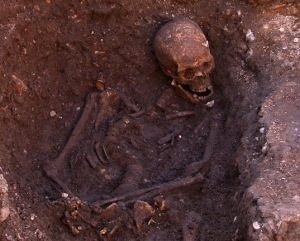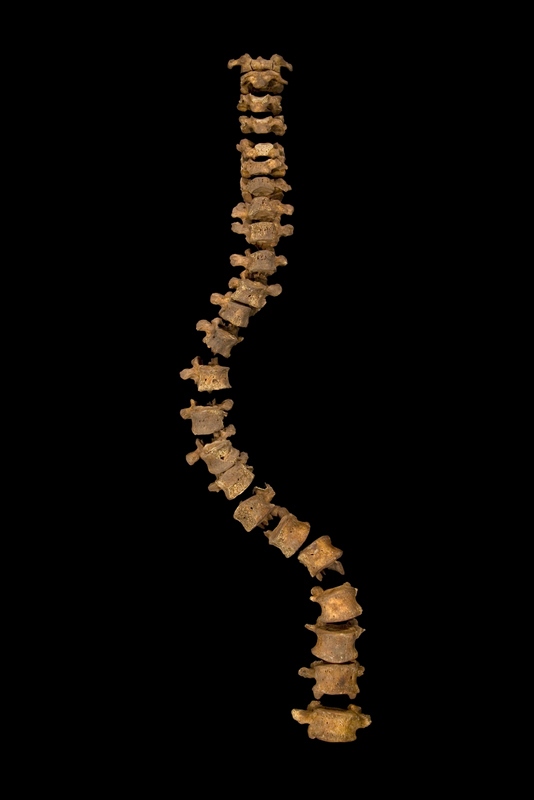
In a paper published May 30 in the medical journal, The Lancet, University of Leicester scientists and multimdia experts have detailed their findings, including the development of a 3-D model, that complete the image of Richard III’s appearance, the famous English king whose remains were recently excavated and identified by archaeologists and who was popularly depicted as a hunchback in Shakespeare’s historical play by the same name.
But it appears, based on the study, that Shakespeare’s Richard was somewhat more of an invention for dramatic effect than it was a depiction of his true appearance.
Led by University of Leicester osteoarchaelogist Dr. Jo Appleby of the University’s School of Archaeology and Ancient History, the team of researchers were able to reconstruct an accurate visualization that revealed how the king’s spine had a curve to the right, but also a degree of twisting, resulting in a “spiral” shape. Among the key findings in the paper are:
- Richard III had a severe scoliosis, with a particularly pronounced right-sided curve;
- Richard’s scoliosis had a “spiral” nature;
- His right shoulder would have been higher than his left, and his torso would have been relatively short compared to his arms and legs, but he had a “well-balanced curve” – meaning that his head and neck were straight and not tilted to one side. In consequence the condition would not have been immediately visible to those he met, particularly if he wore well-designed clothes or armour;
- The Cobb angle – a measurement used to assess the level of spinal deformity in scoliosis patients – was 65-85 degrees. This would be considered a large curvature these days, though many with the condition today undergo surgery to stabilise it;
- His scoliosis would have started to develop during the last few years of growth (after about 10 years of age);
- The researchers already established that Richard would have been about 5ft 8 inches tall without his scoliosis – about average for a man during medieval times. However, his condition meant he would have appeared several inches shorter than this.
During analysis, the skeleton was analyzed macroscopically for evidence of spinal deformity and any changes to the tissue caused by the condition.
The spine was then scanned using computed tomography (CT), with 3D reconstructions of each bone made from the digital model. The team used a 3D printer to create polymer replicas of each vertebra – which were put together to recreate the shape of Richard’s spine during his life.
The polymer reconstruction was photographed from 19 different points, and the pictures were then stitched together digitally to create the interactive 3D model – which can be accessed on any web browser and embedded into websites.
_______________________________
 Images of the spinal column showing curvature at various points of rotation. Credit University of Leicester
Images of the spinal column showing curvature at various points of rotation. Credit University of Leicester
_______________________________
 Complete image of entire spinal column showing the obvious scoliosis condition. Credit University of Leicester
Complete image of entire spinal column showing the obvious scoliosis condition. Credit University of Leicester
______________________________
Dr. Jo Appleby said: “The major finding we have made is being able to reconstruct the three-dimensional nature of the scoliosis and understand what it would have looked like.
“Obviously, the skeleton was flattened out when it was in the ground. We had a good idea of the sideways aspect of the curve, but we didn’t know the precise nature of the spiral aspect of the condition.
“The arthritis in the spine meant it could only be reconstructed in a specific way, meaning that we can get a very accurate idea of the shape of the curve. It’s really good to be able to produce this 3D reconstruction rather than a 2D picture, as you get a good sense of how the spine would have actually appeared.”
“Although the scoliosis looks dramatic, it probably did not cause a major physical deformity. This is because he had a well-balanced curve. The condition would have meant that his trunk was short in comparison to the length of his limbs, and his right shoulder would have been slightly higher than the left, but this could have been disguised by custom-made armour and by having a good tailor.”
“A curve of 65-85 would not have prevented Richard from being an active individual, and there is no evidence that Richard had a limp as his curve was well balanced and his leg bones were normal and symmetric.”
Dr Phil Stone, Chairman, Richard III Society, said: “Examination of Richard III’s remains shows that he had a scoliosis, thus confirming that the Shakespearean description of a ‘bunch-backed toad’ is a complete fabrication – yet more proof that, while the plays are splendid dramas, they are also most certainly fiction not fact.
“History tells us that Richard III was a great warrior. Clearly, he was little inconvenienced by his spinal problem and accounts of his appearance, written when he was alive, tell that he was “of person and bodily shape comely enough” and that he “was the most handsome man in the room after his brother, Edward IV”.
“Thanks must be given to the University of Leicester for the work they have done on the remains, completing the work begun by the Richard III Society.”
____________________________________________
The work was carried out by Jo Appleby, Osteoarchaeologist in the University of Leicester’s School of Archaeology and Ancient History; Professor Bruno Morgan, forensic radiologist in the University of Leicester’s Department of Cancer Studies and Molecular Medicine; Professor Guy Rutty and Alison Brough, of the East Midlands Forensic Pathology Unit, based at the University of Leicester; Dr Piers Mitchell, University of Cambridge; Claire Robinson, University Hospitals of Leicester; and Professor Russell Harris and David Thompson, Loughborough University.
The dig for Richard III was led by the University of Leicester, working with Leicester City Council and in association with the Richard III Society. The originator of the search project was Philippa Langley of the Richard III Society.
Source: Adapted and edited from a University of Leicester press release.
Cover Photo, Top Left: Excavated skeletal remains of King Richard III. Credit University of Leicester
___________________________________________
Read about the most fascinating discoveries with a premium subscription to Popular Archaeology Magazine. Find out what Popular Archaeology Magazine is all about. AND MORE:
On the go? Purchase the mobile version of the current issue of Popular Archaeology Magazine here for only $2.99.
Popular Archaeology’s annual Discovery Edition eBook is a selection of the best stories published in Popular Archaeology Magazine in past issues, with an emphasis on some of the most significant, groundbreaking, or fascinating discoveries in the fields of archaeology and paleoanthropology and related fields. At least some of the articles have been updated or revised specifically for the Discovery edition. We can confidently say that there is no other single issue of an archaeology-related magazine, paper print or online, that contains as much major feature article content as this one. The latest issue, volume 2, has just been released. Go to the Discovery edition page for more information.



